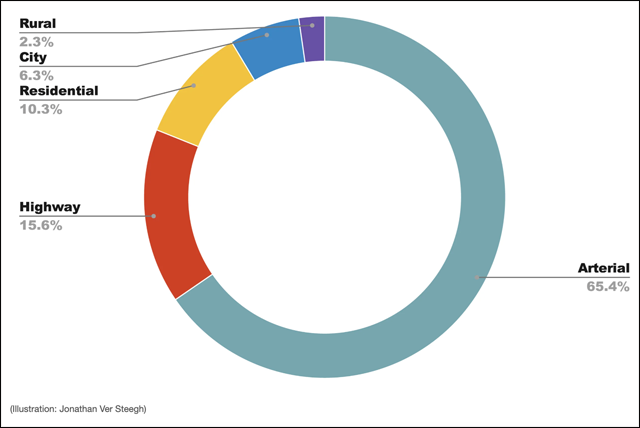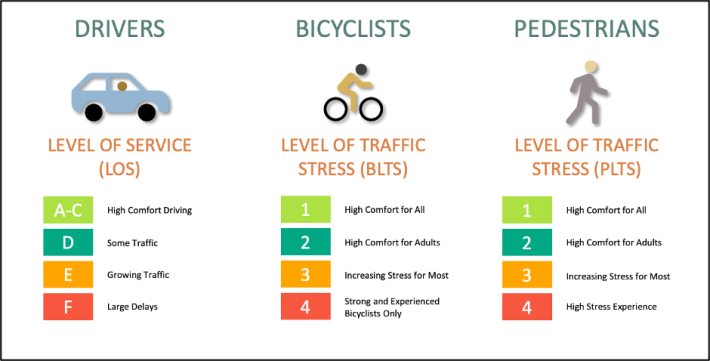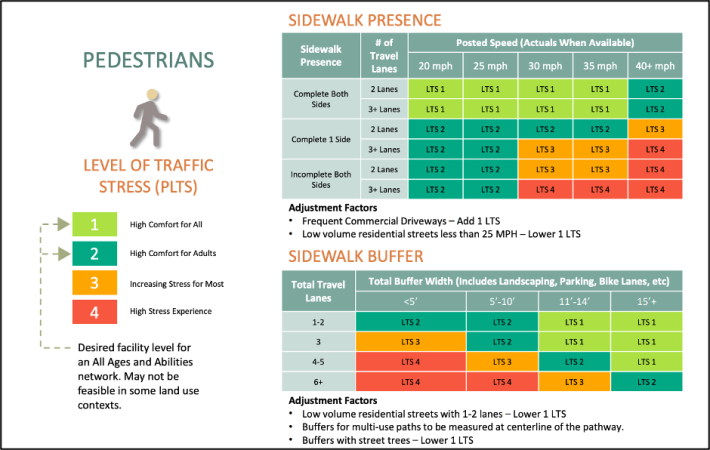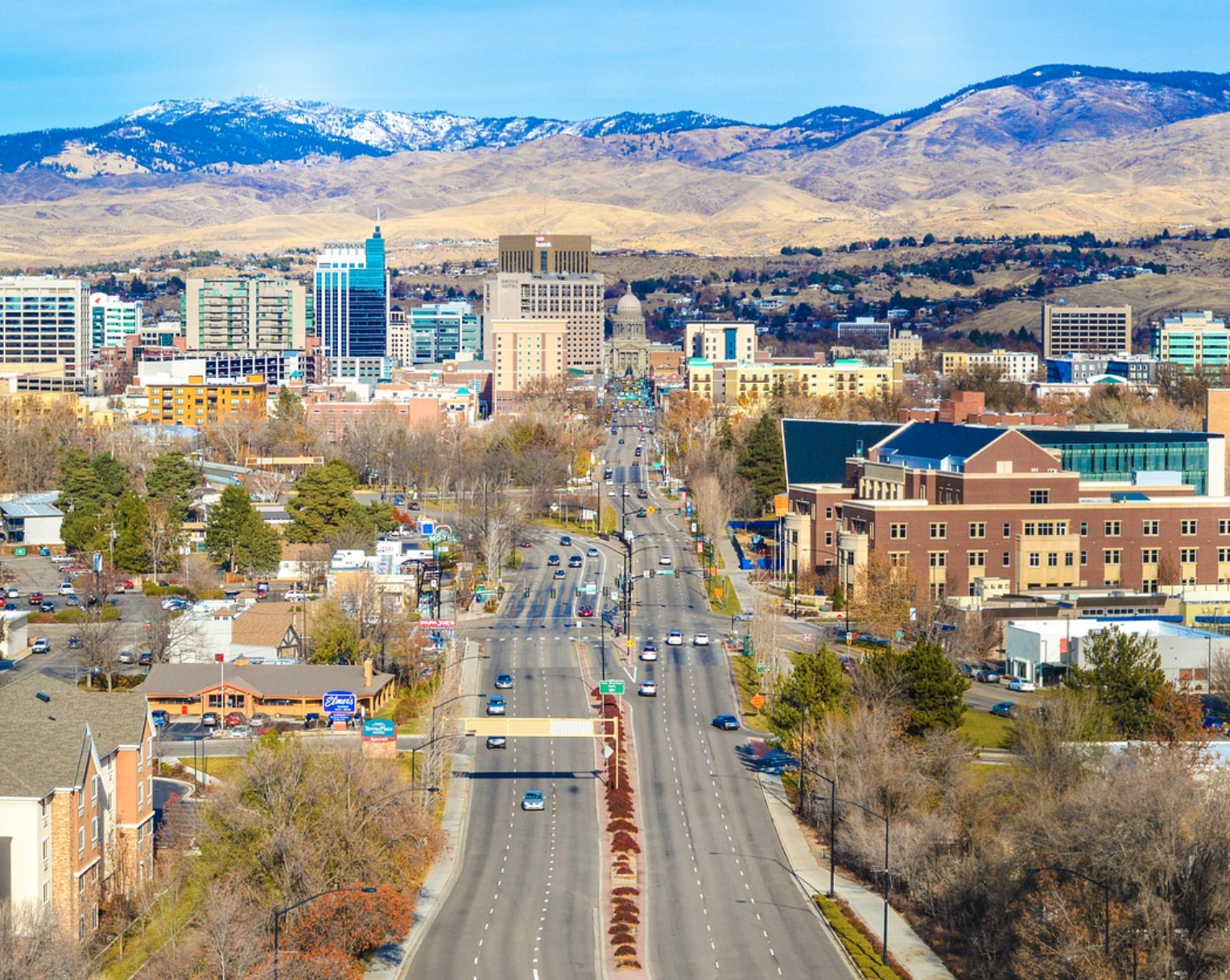A massive transportation authority in Idaho is promising to build protected bike lanes whenever they resurface the most dangerous multi-lane roads in its region, and some advocates think state DOTs across the country should follow that lead.
Earlier this month, Idaho's Ada County Highway District announced that it would no longer build paint-on-the-ground cycling "infrastructure" on arterial roads, prioritizing separated bike lanes or buffered multi-use paths instead. That commitment is unusual for any American transportation agency, but it's a particularly rare for a large regional agency that oversees roads in six predominantly suburban communities where over 80 percent of commuters drive alone to work (the national average in roughly 76 percent).
Still, regional leaders say the move is just common sense — especially because, in the context of a major road maintenance project, adding a little protection for active commuters probably won't cost significantly more than doing nothing at all.
"If we’re closing down a street for maintenance anyway, let’s make sure it’s safe for all modes," said Tom Laws, planning supervisor for the District. "It's really pretty simple. All we’re doing is taking that five-foot bike lane, picking it up, and moving it on the other side of the curb and gutter and perhaps adding a buffer. We’re still early on when it comes to seeing exactly what that cost differential is going to look like, but we’re pretty optimistic."
Boise, Idaho now has more progressive sustainable transportation policy than most large U.S. cities.https://t.co/oY4JuzSpEQ
— Courtney craves chill cycling (@FullLaneFemme) June 10, 2021
Laws says the announcement was not prompted by a spike in crash rates on Ada County's arterials, but by "a desire to move away from the reactionary side of planning to something more proactive." That also makes the District unusual: nationwide, more than 65 percent of fatal bicycle-car crashes last year occurred on such high-speed neighborhood roads. Many forward-thinking urban planners refer to arterials as "stroads," because they combine some of the most dangerous features of roads — namely, multiple lanes of fast vehicle traffic — with features commonly associated with neighborhood streets, like crosswalks, bike lanes, and street-facing commercial businesses, though all three tend to be inadequate.

Of course, state and regional transportation authorities like Ada County were usually the ones who built the stroads dividing U.S. neighborhoods in the first place — an impact that the District is working to reverse going forward. The agency also recently announced that they're changing how they measure the performance of roads under its jurisdiction, de-emphasizing the endless increase of "level of service" for drivers and prioritizing the decrease of "level of traffic stress" for other modes.
Critically, the new guidelines will set new LOS and LTS thresholds that make it perfectly acceptable for drivers to undergo slightly more delays than they do now if it make other road users safe — and make it unacceptable for people who walk and roll to be forced to endure hostile roadway conditions.


Because of ACHD's sheer size and unique structure, that new policy could have a monumental impact. Unlike most U.S. communities, the Highway District alone has jurisdiction over virtually all the roads within its footprint, a sprawling 1,000-square-mile region that includes the capital city of Boise. That means that with the exception of a handful of state-owned highways, Laws estimates that between 95 and 97 percent of the county's arterials are under their direct control — and they don't need to fight through bureaucratic deadlock just to build a simple bike lane.
"In a traditional structure, you’d have six different city agencies handling a lot of these questions," said Laws. "If there was a big snow storm that effected multiple cities, for instance, every individual DOT would have to coordinate with one another to get snowplows where they needed to go to get the roads cleared. We don't have to do that; we can just pool our resources from across the District and get it done."
That streamlined structure and massive reach might make it seem like Ada County's big multimodal win isn't portable to other communities. But some advocates say that comparable shifts could still be transformative on a city scale — and it'd be even better if state DOTs follow its lead.
"ACHD is more like a state DOT than they are a city street department in that they manage a largely suburban street network of arterials and have substantial resources to upgrade them with protected bicycling facilities," said Boise-based planner and multimodal advocate Don Kostelec. "[The bike lane policy is] significant as an example for other state DOTs to model in their systems, given many of them probably operate more roadway miles in areas more similar to ACHD's suburban grid network than they do in central cities."
Laws adds that transportation leaders probably have a stronger mandate to retrofit their streets than they might think — if they just take the time to engage with the people who use them most.
"Listen to your residents," said Laws. "We have three very active advisory groups, and they’re not planning professionals; they’re people out there riding every day, putting boots on the ground and experiencing the network in the first person. And we were hearing over and over again from these folks and others that the residents of Ada County wanted more. They want these facility types where you could have the grandparents riding their bikes, or their kids riding their bikes, and we know there are examples from across the country where [protected bike infrastructure] is working. So we listened."






